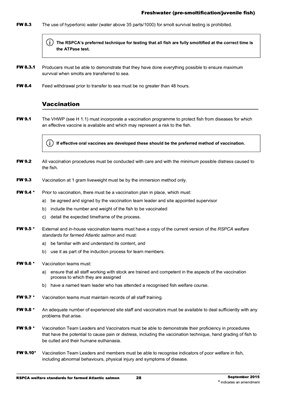
Freshwater (pre-smoltification/juvenile fish)
RSPCA welfare standards for farmed Atlantic salmon 28 September 2015
* indicates an amendment
FW 8.3 The use of hypertonic water (water above 35 parts/1000) for smolt survival testing is prohibited.
The RSPCA's preferred technique for testing that all fish are fully smoltified at the correct time is
the ATPase test.
FW 8.3.1 Producers must be able to demonstrate that they have done everything possible to ensure maximum
survival when smolts are transferred to sea.
FW 8.4 Feed withdrawal prior to transfer to sea must be no greater than 48 hours.
Vaccination
FW 9.1 The VHWP (see H 1.1) must incorporate a vaccination programme to protect fish from diseases for which
an effective vaccine is available and which may represent a risk to the fish.
If effective oral vaccines are developed these should be the preferred method of vaccination.
FW 9.2 All vaccination procedures must be conducted with care and with the minimum possible distress caused to
the fish.
FW 9.3 Vaccination at 1 gram liveweight must be by the immersion method only.
FW 9.4 * Prior to vaccination, there must be a vaccination plan in place, which must:
a) be agreed and signed by the vaccination team leader and site appointed supervisor
b) include the number and weight of the fish to be vaccinated
c) detail the expected timeframe of the process.
FW 9.5 * External and in-house vaccination teams must have a copy of the current version of the RSPCA welfare
standards for farmed Atlantic salmon and must:
a) be familiar with and understand its content, and
b) use it as part of the induction process for team members.
FW 9.6 * Vaccination teams must:
a) ensure that all staff working with stock are trained and competent in the aspects of the vaccination
process to which they are assigned
b) have a named team leader who has attended a recognised fish welfare course.
FW 9.7 * Vaccination teams must maintain records of all staff training.
FW 9.8 * An adequate number of experienced site staff and vaccinators must be available to deal sufficiently with any
problems that arise.
FW 9.9 * Vaccination Team Leaders and Vaccinators must be able to demonstrate their proficiency in procedures
that have the potential to cause pain or distress, including the vaccination technique, hand grading of fish to
be culled and their humane euthanasia.
FW 9.10* Vaccination Team Leaders and members must be able to recognise indicators of poor welfare in fish,
including abnormal behaviours, physical injury and symptoms of disease.
i
i